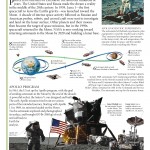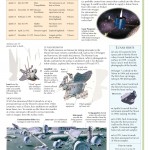People have dreamed of exploring the Moon for hundreds of years. The United States and Russia made the dream a reality in the middle of the 20th century. In 1959, Luna 1- the first spacecraft to leave the Earth’s gravity – was launched toward the Moon. A decade of intense space activity followed as Russian and American probes, robots, and crewed craft were sent to investigate and land on the lunar surface.
The Clementine space mission, launched in 1994, and Lunar Prospector, launched in 1998, found evidence that water ice is hidden in shadowed craters in the Moon’s Polar regions. The ice probably comes from comets that crashed into the Moon long ago. It could be either melted to supply a future Moon base with water, or broken down into oxygen for astronauts to breathe and into hydrogen for rocket fuel.
Related posts:
The Apollo Lunar Module basically has five configurable parts that are used for the Lunar Landing Mission. The top most tip called as Command Module where all the commands execution takes place. The second component called as Service Module offers all the aided services that are to be offered to all the other components. Third is Spacecraft/Lunar Module adapter that looks after all the electri...
What qualifies as low entropy or high entropy depends on the situation. Physicists identify the high – entropy state of a system based on how the system evolves over time. For example, if a diffuse and sufficiently cool gas feels the tug of gravity, it evolves to a clump. The law of entropy increase then implies that the clump has high entropy, even though at first glance it might appear to be...
Electrons unite with protons and neutrons to structure particles, ordinarily hydrogen and helium. Light can at final sparkle. Gravity makes hydrogen and helium gas mixes to shape the goliath fogs that can come to be universe sized frameworks; more unobtrusive packs of gas ruin to structure the first stars.
When a Metorite collides with Earth it can form an impact crater – a bowl – shaped hollow in the Earth’s surface. Space rocks have produced in this way throughout Earth’s life, especially when the planet was young, about 4 billion years ago. Space rocks do not have to hit Earth to have a devastating effect. On june 30, 1908, there was an explosion 3.5 miles up in Earth’s atmosphere, above...
A star chart or star map is a map of the night sky. Astronomers divide these into grids to use them more easily. They are used to identify and locate astronomical objects such as stars, constellations and galaxies. They have been used for human navigation since time immemorial.
The “dark flow” of wayward galaxy clusters that appear to be pulled in one direction could give us our first hint of something beyond the cosmic horizon, which normally marks the limit of the observable universe.
The Lunar module Descent stage would be the final module for the vehicle. The Stage consists of the Engine Mount, The Descent engine, the Structural Skin, the Insulation, the thermal and micrometeoroid shield, the forward interstate fitting, the oxidizer tank, the cable cutter, the ambient helium tank, the landing gear and finally the descent engine skirt.
Venus is called a mediocre planet being as how it circles closer to the Sun than the Earth does, Venus is a circle of rock comparable in size to the Earth – But there the examination finishes. Venus is a dull, dangerous universe of volcanoes and suffocating environment. Its normal temperature is higher than that of whatever available planet. From Earth, we can see just the planet's clout tops.&nbs...
The divine circle might be acknowledged to be interminable in sweep. This denotes any focus within it, incorporating that involved by the spectator, might be recognized the inside. It moreover indicates that everything parallel lines, be they millimeters separated or crosswise over the Earth's planetary group from one another, will appear to cross the circle at a lone indicate, comparable to the v...
Majority of the Apollo Lunar Components are more sensitive and they have to be treated very carefully. It contains components like Rendezvous radar antenna, environmental Control System module, Crew Compartment. A crewman handles all these components with utmost care. Reaction Control thruster assembly, ascent propulsion, Red Docking Light, Egress Platform, Fuel tank, Descent Engine, Lunar Sur...
The "Messier Objects" were unknown objects in the sky, first noted from France astronomer Charles Untidier in his "List diethylstilbestrol Nébuleuses et diethylstilbestrol Amas d'Étoiles" ("Catalogue of Formulations and Superlegend Clusters"). It was initially released in 1771, with the final inclusion, made from later astronomers, manufactured in 1966. Messier objects were things in the sk...
The sequence of the universe portrays the history and fate of the universe consistent with Enormous detonation cosmology, the predominant exploratory model of how the universe started to exist and advanced as time passes, utilizing the cosmological time parameter of commoving facilitates. The moment in which the universe is thought to have started quickly extending from an extensively towering for...
Stellar advancement is the methodology by which a star experiences an arrangement of radical updates around its lifetime. Hinging on the mass of the star, this lifetime extends from just a few million years for the most gigantic to trillions of years for the slightest huge, which is impressively longer than the time period characterized by the universe. All stars are born from falling mists of...
A eclipse occurs when the Moon passes straight at the rear of the Earth into its umbra (shadow). This will happen only once the sun's rays, Earth, and Celestial satellite are aligned specifically, or extremely closely thus, using the World in the middle. Therefore, the eclipse can only occur the night time of your full-of-the-moon. The sort and also period of a great eclipse depend upon the Mo...
Consistent with Aristotle, the sublime forms are the absolute best substances, (or "substances"), whose movements are administered by standards different than these of forms in the sublunary circle. The last are made out of one or every last trace of the four traditional components (earth, water, air, blaze) and are perishable; anyhow the matter the sky are made of is enduring ether, so they a...
The Solar system comprises of the Sun and its planetary framework of eight planets, their moons, and different non-stellar questions. It shaped roughly 4.6 billion years back from the breakdown of a monster sub-atomic mist. The unfathomable larger part of the framework's mass is in the Sun, with the majority of the remaining mass held in the planets. The four more diminutive internal planets, Merc...
The Sun is our nearest star. It is a huge, luminous ball of gas like all the other stars. It consists mostly of hydrogen, and helium with tiny amounts of other elements. The Corona is the outer shell of the Sun’s atmosphere. It is extremely hot with temperatures reaching up to 2 million degrees. In the radiation zone, the energy is transported outwards by radiation. It covers about 70% of the Sun’...
In the connection of spaceflight, a satellite is an item which has been put into space by human endeavour. Such protests are now and again called simulated satellites to recognize them from instinctive satellites for example the Moon.



 Upload your infographic here and contribute to our community.
Upload your infographic here and contribute to our community. 
Leave a Reply